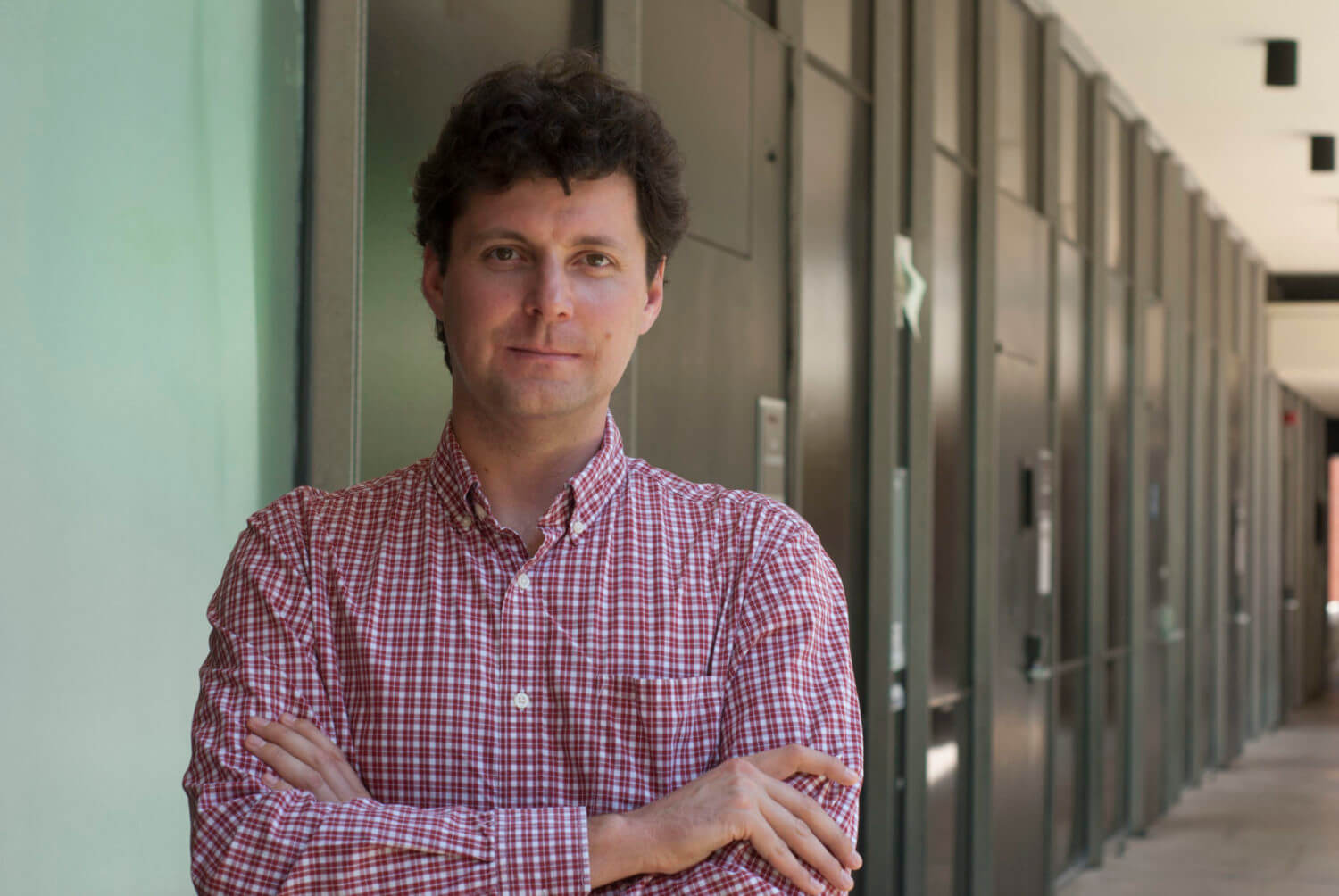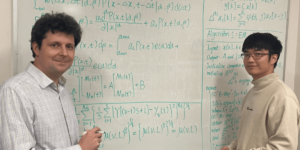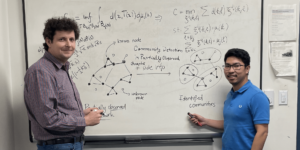
Professor Paul Bogdan of the Ming Hsieh Department of Electrical Engineering works on research that could teach old drugs new tricks Photo/Daniel Druhora
In the fall of 2016, Nature published groundbreaking research by USC Viterbi Assistant Professor Paul Bogdan and an international team of scientists. The 2015 NSF CAREER Award recipient found an entirely new method of examining previously unexplored interactions between thousands of pharmaceuticals. His findings could lead to the discovery of new drugs and the possibility of teaching old drugs new tricks. Among his other endeavors, Bogdan develops micro-robotic swarms of propelled bacteria for drug delivery and optimizes cyber-physical systems for artificial organs and medical devices. As Bogdan’s paper, “Clustering drug-drug interaction networks with energy model layouts: community analysis and drug repurposing,” will likely pave a new path in drug repurposing, we sat down with Bogdan to discuss the revelations and ramifications of his latest published work.
We are the first to analyze the drug-drug interaction networks with both modularity classes and force-directed network layouts. Normally, such techniques are used in social network analysis. Therefore, in a way, we are looking at drugs as if they were individuals who interact and inter-relate in a social network.
What was the significance of this research?
Our work presents a systematic methodology based on big data and complex networks for linking drug interactions to pharmacological properties. In other words, we start with a big database of drug interactions in order to generate drug clusters which correspond to certain pharmacological properties such as immune system related drugs or drugs acting on cytochrome P450 enzyme system. We have electronically verified the accuracy of our predictions by searching state-of-the-art literature that reports newly found drug properties.
We were amazed to find that 85 percent of our predicted properties are confirmed by the latest scientific discoveries in the fields of medicine, pharmacy and biology. For the remaining 15 percent of the analyzed drugs, the properties suggested by our clustering technique are new or unexpected, and this can pave the way for drug repositioning. It is generally easier and cheaper to find and document such interactions than to generate drug-targets or chemical structures, which entail a lot of effort to investigate. Information about drug-drug interactions can be found even in social media, for instance. Therefore, to some extent, our effort contributes to bridging the gap between drug design – on the one hand – and social networks, social media – on the other hand.
Who will be directly impacted by your work and be likely to apply it?
I think that the first to use our work are those researchers who are looking for drug repositioning hints in order to perform in vitro and in vivo experiments for confirmation, thus leading to new therapies.
For instance, our methodology reveals a general relationship between cancer and epilepsy, based on peripheral overlapping of the two drug communities.
Here are two such pertinent and substantial examples from our computational drug repositioning method, which are supported by recent medical research. Disulfiram, a proepileptic drug, is predicted by our method as a potential anticancer drug; indeed, recent research reports disulfiram as having anticancer properties. Our methodology also predicts that medroxyprogesterone and megestrol have antineoplastic endocrine properties; normally, these drugs are considered only as anticonvulsants. However, the connection between antineoplastic endocrine drugs and epilepsy is validated by the recent medical research of S.M. Sato & C.S. Woolley (eLife 5, e12917, 2016), which reports that endocrine anticancer drugs letrozole and fadrozole substantially mitigate seizures.
Moreover, our clustering technique uncovers new potential properties for 15 percent of analyzed drugs, so we expect that other confirmations will follow in the near future. As such, we propose some hints for further medical investigation: chlorzoxazone and trimethadione seem to be related with cancer, the hypoglycemic agent liraglutide interfere with platelet function or kalemia level, and so on.
Why type of drugs did you analyze and how did do decide to look at them in particular?
All types of drugs that can be found in the DrugBank database. The only drugs we excluded are those which have no interactions because there was no way to connect them in a drug-drug interaction network. We can get a bird’s eye view on the rendered drug-drug interactions communities only if we consider all drugs within the database.
We analyzed over 7,000 drugs, and a staggering 1,141 drugs were ultimately found to have unique drug-drug interactions.
What did you choose not to look at and why?
Well, we wanted a very general approach, therefore we tried to take as much as possible into account. One thing that we did not look into is the distinction between drug interaction types, such as synergistic and antagonistic interactions, because we considered that there is no need for such discrimination in our clustering procedure.
You mention that the method can help us rank drugs according to their interaction potential for both simple and complex multi-pathology therapies. Does that mean that drugs are ranked based on certain pharmacological properties that can be used to treat multiple diseases at once? Can you give some real-world examples of what type of multi-pathology therapies this can impact?
This ranking is based on network metrics, not on pharmacological properties. In fact, when the interaction network is built, we do not use information about pharmacological properties. Those properties emerge from running the network layout. So, what our ranking actually means is that a drug with high betweenness has a high probability of interacting with other drugs, especially when several medical conditions – along with the corresponding drug therapy – are associated.
For instance, rifampin, which is a drug used for the treatment of tuberculosis, has a high betweenness value (consequently, an interaction potential), thus suggesting a careful and prudent therapeutic regimen, when tuberculosis is associated with other pathologies that also require medication, such as cardiovascular or psychotic disorders.
What finding did you find the most surprising?
Well, we were both surprised and amazed to see the extent of confirmation of our predicted drug repositionings. We are talking about the most recent experimental medical and pharmaceutical discoveries. Our supplementary material presents many such examples.
Our research provides a general and accurate framework which takes a big collection of drug interactions in order to predict new pharmacological properties for those drugs. Also, our approach provides an intuitive, visual representation on drug interactions.
How can the clustering approach be used for phenotyping patients in personalized medicine applications? For instance, in cancer, would it also be analyzed in concert with the cancer genome atlas since all cancers have different gene expression data?
Our clustering technique is able to show how, for a given disease, the various considered factors converge and associate in large groups of patients; this is how we can define phenotypes. Indeed, besides metabolome, diseasome, and different types of interactomes, one such factor can be the human genome.
How did the research team come together? Why did you all connect on this topic?
The idea of using our engineering background in order to undertake research in complex systems came when I met Mihai Udrescu in Pittsburgh five years ago. He was a visiting researcher at Carnegie Mellon University while I was a Ph.D. student there. Mihai is a computer engineer based at University Politehnica in Timisoara, Romania, who at that time was trying to find new momentum for his research. We can trace back the seminal ideas that underpin our work to this particular moment: the summer of 2011.
The second relevant moment is the summer of 2013 when Mihai presented our ideas to his wife, who is a pharmacist and at that time was working on her Ph.D. project. This way, our network science perspective connected with the field of system pharmacology, drug design, and drug repositioning. That’s how our team has assembled: Lucretia Udrescu with her Ph.D. advisor, Professor Ludovic Kurunczi (Research Institute of Chemistry of the Romanian Academy), and department colleague Laura Sbarcea (Faculty of Pharmacy from the University of Medicine and Pharmacy Timisoara), myself, and Mihai Udrescu with his postdoc team (Alexandru Topirceanu and Alexandru Iovanovici) from his engineering university.
You’ve published twice in Nature. How difficult is it get something published in Nature?
The process is a very competitive since Nature is a highly ranked publication. The review stages can sometimes be laborious and demanding, but they can pose new interesting questions that can prompt the development of new research directions. You can appreciate this thorough review process only at the very end when the paper gets finalized and have thousands of new questions and tens of research directions.
Are you thinking of taking this research to the next level? What would that look like?
We plan to try to combine our methodology with other drug repurposing strategies, working from a structural perspective on drug-target interactions or chemical structure relationship networks. Such an endeavor will be extremely complex, so I think we will focus on specific disorders and diseases instead of using our current general approach that takes them all into consideration.
What are you working on now?
Right now, we are reading a lot of scholarly literature as we try to better relate our framework and ideas to complementary drug repositioning approaches.
We definitely do not feel satisfied. We are hungry for knowledge, now more than ever.
Published on January 23rd, 2017
Last updated on March 10th, 2017










